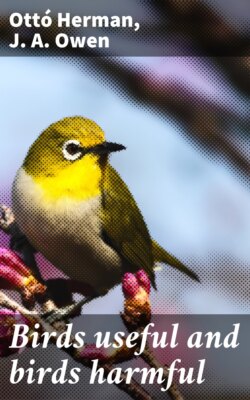Читать книгу Birds useful and birds harmful - J. A. Owen - Страница 8
На сайте Литреса книга снята с продажи.
Оглавление“An Owl that in a barn
Sees a mouse creeping in the corn,
Sits still and shuts his round blue eyes
As if he slept, until he spies
The little beast within his reach,
Then starts, and seizes on the wretch.”
“Not a bird of the forest e’er mates with him,
All mock him outright by day,
But at night, when the woods grow still and dim,
The boldest will shrink away.”
But why this is so who can tell? If the Barn Owl shows himself by day, Rooks and Starlings, Blackbirds, both species of Thrush, Chaffinches, Tits and Wrens will mob him; and he flies awkwardly from tree to tree, with dazed eyes and apparently “mazed,” as the country folks says, altogether, till he can find a hole in a tree where he can hide himself. He may well like hollows in trees—for, as the poet says, “the Owl, with all his feathers, is a-cold.” This is not hard to understand, for the breast feathers are so light and fluffy that the wind easily parts them, laying bare the shivering skin.
His frequent choice of an old dovecote as a home was misunderstood. The ignorant countryman thought it was in order to prey on the young pigeons that he selected a corner there, whereas—and Waterton was the first to record the bird’s reason, after watching the doings of a pair of Barn Owls in his dovecote—the Owls were there to prey on the pigeons’ enemies, and Owls and Pigeons lived amicably together in the same home.
Lord Cathcart, in a paper contributed to the Royal Agricultural Society, said: “Our ancestors, wiser than we, always made in their great barns ingress for Owls—an owl-hole, with often a stone perch.” And the Rev. F. O. Morris tells of a pair of this species which lived in a barn near Norwich, and were so fearless that they would stay there whilst the men were threshing; they waited on the flails as rooks do on the plough, and if a mouse were dislodged by the removal of a sheaf they would pounce upon it without minding the men’s presence. They hunt mice amongst the stacks, too, in the farmyard, staying there all night often, if mice abound. As E. Newman says, “The farmer pays the price of a sack of grain for every Owl nailed to his barn door, because that Owl would have destroyed mice every night, and these mice, being relieved of their oppressive enemy, would, in a very short time, consume a sack of wheat, peas, or beans.”
Owing to its very deep plumage, the Barn Owl looks larger than it is. Its eye is dark-coloured, almost black: its glance is directed forwards. The facial disk is very prominent; at rest, it is heart-shaped, and it is edged with white and rust-colour. The bill is yellowish in colour, and is slightly hooked. The legs are scantily feathered, and the toes almost bare: the claw of the middle toe is serrated along its inner edge. The body-plumage is soft as silk, and yielding, and thickly pearled with white and dark markings on the beautiful ash-grey back. The flanks are pale with a reddish tinge, in places very bright, and sprinkled with tiny pearl-like spots of light and dark colour.
